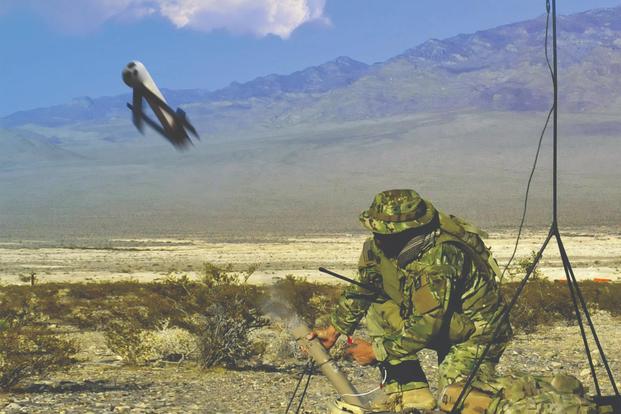As the Marine Corps continues its quest to get more capability from long-range precision fires, it's asking industry for proposals on a portable system that can fire high-tech attack and reconnaissance drones on the go.
The service released a request for proposals Monday describing a futuristic system unlike any of its existing precision-fires programs.
The theoretical weapons system, which the Corps is simply calling Organic Precision Fire, needs to be capable of providing fire support at distances of up to 60 kilometers, or more than 37 miles, according to the RFP document.
This range would exceed that of the M777 155mm howitzer, which can fire Excalibur rounds up to 40 kilometers, or around 25 miles.
The system, which ideally would be light enough for just one Marine to carry, would launch loitering munitions from a canister or tube no larger than 10 inches across and eight feet long. The projectile would be able to loiter for up to two hours, according to the solicitation, while gathering data and acquiring a target.
Loitering munitions, known informally as suicide or kamikaze drones, are unmanned aerial vehicles, typically containing warheads, designed to hover or loiter rather than traveling straight to a target. They're becoming increasingly common on the battlefield.
The California-based company AeroVironment's Switchblade loitering munition is now in use by the Marine Corps and Army. It is described as small enough to fit inside a Marine's ALICE pack. The Blackwing UAV, also made by AeroVironment, is tube-launched, but designed to perform intelligence, surveillance and reconnaissance, rather than to attack.
The Marines want whoever can make the system they seek to give it the ability to communicate securely with a ground control system at a distance of up to 60 kilometers. It should also be advanced enough to perform positive identification on a target, and engage and attack a range of targets including personnel, vehicles and facilities.
Companies have until May 18 to submit proposals to the Marine Corps on such a system.
The ambitious RFP comes shortly after the Corps issued a request for proposals on the manufacture of the Advanced Capability Extended Range Mortar, or ACERM, a round that will almost quadruple the range of the current M252 81mm mortar system.
Service leaders have publicly said they're planning to make big investments in the field of long-range precision fires as they prepare for future conflicts.
The commanding general of Marine Corps Combat Development Command, Lt. Gen. Robert Walsh, told Military.com in December that the service was making decisions to divest of certain less successful weapons systems in order to shift more resources to developing these capabilities. The service had already done so, he said, with its 120mm towed mortar system, the Expeditionary Fire Support System.
"We made that decision to divest of it, and we're going to move that money into some other area, probably into the precision fires area," Walsh told Military.com. "So programs that we see as not as viable, this [program objective memorandum] development that we're doing right now is to really look at those areas critically and see what can we divest of to free money up to modernize."
-- Hope Hodge Seck can be reached at hope.seck@military.com. Follow her on Twitter at @HopeSeck.










